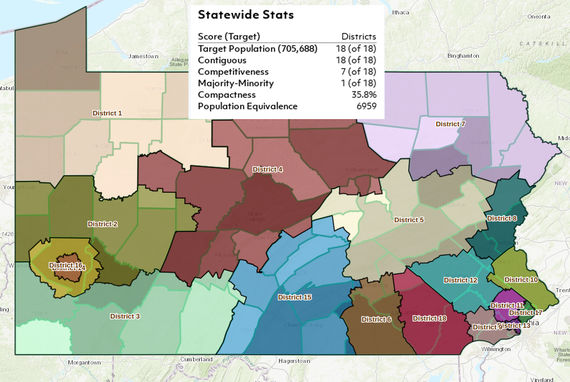Team Bullseye, Mercyhurst University, 2nd, Higher Ed-West

About Team Bullseye, Sophia Jensen: I am a political science and intelligence studies honor student at Mercyhurst University. I am from Tempe, AZ, but am proud to call Western Pennsylvania my home away from home. I am vice president of the Mercyhurst Student Government, help manage the Mercyhurst Center for Applied Politics and the Anti-Human Trafficking Intelligence Cell, and play the bass clarinet in the Wind Ensemble. Logan Ford: I was born and raised in Erie, PA. I am a third-year student at Mercyhurst, pursuing majors in intelligence studies and political science. I wanted to make a map to gain a greater comprehension and appreciation of how the districting process works as well as the difficulties and complications that arise during it.
Judges' statement
This map by Sophia Jensen and Logan Ford shows great insight and creativity. Its districts are more compact and competitive than the current congressional district map. Additionally, the design of the districts (specifically those in Allegheny County) was unique.

Personal statement
The ultimate goal of the proposed map is to foster more bipartisan, moderate policy in the U.S. House of Representatives. We the creators are a bipartisan force ourselves, and consulted other political scientists to find the best way to encourage unbiased representative democracy. To this end, we focused on the following elements when drawing the district lines: equal population, compactness, communities of interest, and competitiveness.
The proposed districts overall are nearly 3 percentage points more compact than the current districts.
We tried to create congressional districts that closely aligned with the communities of interest they encompass, particularly focusing on where residents identify as “home.” Though Districts 14 and 16 may look odd, this configuration allows those from the city of Pittsburgh proper to be represented together, and those from the suburbs to be represented together as well, no matter what side of the city they live on. We interviewed Pennsylvanians from across the state to learn how they described their community when planning our district lines. We also consulted the current turf breakdowns of political parties and examined the key changes between the old and new district lines.
By making the individual districts more competitive when possible, the candidates should theoretically become more moderate. As a candidate and a representative, they would have to work to satisfy constituents on both sides of the spectrum and would thus work to find a common ground.
The inherently more Democrat-leaning cities will be balanced by the rural districts of the state, which would be competitive, but still have a Republican advantage. Seven of the proposed districts are marked as competitive, two more than in the current configuration. By focusing on communities of interest first, then evaluating and promoting competitiveness, you can nurture moderate legislation without having to combine vastly different communities in districts.
These population-balanced, compact, competitive districts were created in part by splitting some counties and municipalities between districts. These splits encourage the representatives to learn more about their constituents on the local level instead of generalized at the county level and increases the amount of political attention paid to those areas. A county that is split between two districts has more representatives to hear their wants, needs, and opinions, and is more likely to see a result because of it.